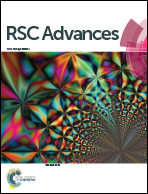Hierarchical porous CuO nanostructures with tunable properties for high performance supercapacitors†
Abstract
We report a novel, low-cost strategy to synthesize copper oxide (CuO) nanostructures as high-performance supercapacitor electrodes using an alkaline solution oxidation method. The structure, morphological features, surface area and pore size distribution of the products are tuned using different types of surfactants. The CuO electrode obtained from sodium dodecyl sulfate (SDS) presents the best electrochemical performance due to the synergies arising from the large surface area and pore volume created by the ultrathin nanoleaves constituting the flower-shape nanostructure. The electrode delivers a remarkable specific capacitance of 520 F g−1 at 1 A g−1 and a high rate capacitance of 405 F g−1 at 60 A g−1 with more than 95% Coulombic efficiency after 3500 cycles.


 Please wait while we load your content...
Please wait while we load your content...